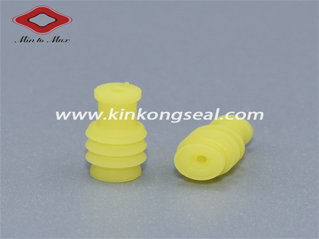Nov. 18, 2020
Silicone is one of the indispensable and important materials in automobile manufacturing. It can not only optimize the automobile manufacturing process but also improve the performance and safety of the automobile. It has been widely used in various automotive parts, such as airbag coatings. Power transmission seals, gaskets, hoses, windshield linings, automotive engine seals, ignition wires and coil sheaths, automotive turbocharger pipe cooling pipes, sealing and protection of automotive components, high-voltage cables, and wiring harness sealing, etc. And the use of automotive connectors wire is increasing. Today, we will mainly introduce the application of silicone rubber material in silicone on cables for new energy vehicles.

Silicone rubber is a kind of silicone elastomer material, which is different from petroleum-based polymer materials. It comes from silicate ore in the earth's crust.
Through specific formula design, silicone rubber has shown its special advantages in the field of new energy automobile cables.
So what is silicone rubber? Silicone rubber refers to a rubber in which the main chain consists of alternating silicon and oxygen atoms, and two organic groups are usually attached to the silicon atoms. Ordinary silicone rubber is mainly composed of siloxane chain links containing methyl groups and a small number of vinyl groups. The introduction of phenyl groups can improve the high and low-temperature resistance of silicone rubber, and cyano groups can increase the performance of silicone rubber. Temperature and oil resistance.
According to different curing methods and base polymer viscosity, in addition to heat curing and cold curing, silicone rubber can also be divided into the following categories:
Solid silicone rubber (HTV), liquid silicone rubber (LSR), two-component room temperature vulcanized silicone rubber (RTV-2), one-component room temperature vulcanized silicone rubber (RTV-1), silicone gel, etc.
Silicone rubber has good low-temperature resistance. Generally, it can still work at -55℃, and it can reach -73℃ after introducing phenyl.
Silicone rubber also has outstanding heat resistance. It can work for a long time at 180°C and can withstand a few weeks or longer when it is slightly higher than 200°C, and it can withstand temperatures above 300°C instantly.
Silicone rubber has good air permeability, and its oxygen transmission rate is the highest among synthetic polymers.
Single wire Seal is used more and more widely in cars. With the increasing global energy shortage and the increasingly serious environmental degradation, energy conservation and emission reduction have made new energy vehicles the development direction of the global automotive industry. New energy vehicles include hybrid electric vehicles (HEV), pure electric vehicles (BEV), and fuel Battery cars (FCEV), hydrogen engine cars, gas cars, alcohol ether cars, etc.
Compared with traditional fuel vehicles, hybrid and pure electric vehicles have added many high-voltage accessories, such as power batteries, high-voltage power distribution boxes, drive motors, and motor controllers. This also places new requirements on automotive cables. Because these cables are arranged in the engine and chassis area of the front compartment, the temperature is high and the space is small, the cables need to be flexible, small turning radius, and good high and low-temperature resistance; secondly, the road conditions are complex, and the cable must have good wear resistance and high mechanical strength; In addition, the vehicle speed is high and sometimes low, especially in harsh working conditions such as full-load climbing. The instantaneous high current requires the cable to have short-term overload capability.
In summary, the new energy vehicle cable must have good electrical insulation performance; thermal stability, weather resistance; corrosion resistance, oil and hydrophobicity, excellent flame retardancy; superior comprehensive mechanical properties, high flexibility, and high tear resistance Crack, and so on.
Currently, there are cross-linked polyolefins and thermoplastic elastomers as insulation materials for automotive power cables. Among them, the cross-linked polyolefin material has a heat resistance of up to 150°C, but the material cable is relatively hard, inconvenient to install in a small car body space, and requires irradiation cross-linking, the process is complicated, and it is not suitable for large cross-section cables. The heat resistance of the thermoplastic elastomer material does not exceed 125°C, and the temperature level used for power cables is low, and the cable of the thermoplastic elastomer material may be at risk of cracking after long-term use.
Silicone rubber has high and low-temperature resistance, ozone resistance, weather resistance, and excellent electrical insulation; silicon rubber wire has a large current carrying capacity, saves conductor cross-section, and can cope with long-term full-load operation requirements; it can meet the requirements of fire resistance by adding flame retardants; High flexibility, easy to install in a limited space; high tear-resistant silicone rubber, trousers tear up to 25N/mm. Therefore, silicone rubber materials can make up for their shortcomings while integrating the advantages of cross-linked polyolefin and thermoplastic elastomer materials, and silicone rubber can reduce vehicle weight and carbon dioxide emissions, and is a good choice for automotive power cables.
Tel: +86 13705057546
E-mail: info@kinkong.com
Add: #27 Hengjing Xiyi Road, Liushi Town, Yueqing City, Zhejiang Province, 325604, China.
Copyright © Min To Max All Rights Reserved |